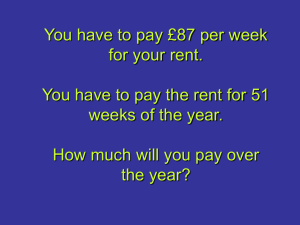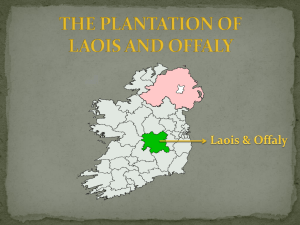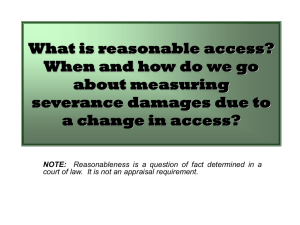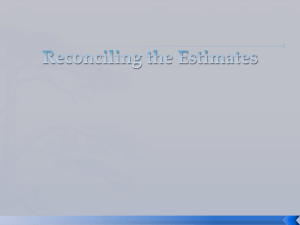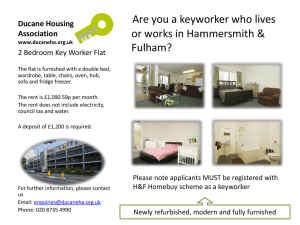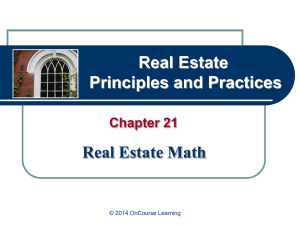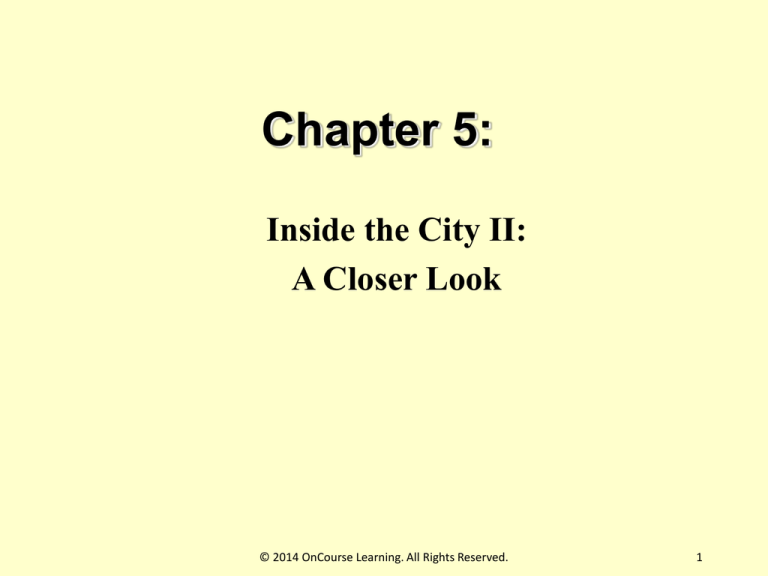
Chapter 5:
Inside the City II:
A Closer Look
© 2014 OnCourse Learning. All Rights Reserved.
1
Introduction
Chapter 4 and the Monocentric City Model
presented the basics, but we need to broaden
our study of urban form and land value to
include some key aspects of the real world
that are important for real estate practitioners
and investors…
© 2014 OnCourse Learning. All Rights Reserved.
2
Chapter 5
Learning Objectives:
The difference between land value and land
rent, and the key determinants of land
values in and around a city.
Why uncertainty can result in higher land
values but less land development in a city.
Why different land uses and densities occur
at different locations within a city.
© 2014 OnCourse Learning. All Rights Reserved.
3
Chapter 5
Learning Objectives (cont’d):
How neighborhoods grow and mature and
sometimes decline and rise again.
The concept of property life cycle, and its
implications for real estate investors.
The nature and cause of the major
characteristics of the urban form of the
typical American city, and how this form
has been changing.
© 2014 OnCourse Learning. All Rights Reserved.
4
Effect of Urban Growth & Uncertainty on Land Rents & Land Values Just
Beyond the Urban Boundary
When you develop today, you give
up the option to develop tomorrow
instead. Devlpr needs to be
compensated for loss of this option.
Exhibit 5-1: Components of Land Rent Outside &
Inside the Urban Boundary, Under Uncertainty . .
.
Location Rent
Irreversibility Rent
Construction Rent
Agricultural Rent
B
Distance from
CBD
B = Urban
Boundary
Exhibit 5-2: Components of Land Value Outside &
Inside the Urban Boundary, Under Uncertainty . . .
PV of property asset includes PV of
expected future growth in rents
developed property can earn after its
development.
Location Value
Construction Cost
Irreversibility Premium
Growth Premium
Agricultural Value
Building today vs next yr does not
forego oppty to obtain this growth.
Distance from CBD
B
B = Urban Boundary
© 2014 OnCourse Learning. All Rights Reserved.
5
Effect of Urban Growth & Uncertainty on Land Rents & Land Values Just
Beyond the Urban Boundary
As boundary expands,
land value just beyond
boundary can grow
rapidly, due to increase
in growth premium &
irreversibility (option)
premium values,
depending on how fast
the boundary is
expanding, and the
magnitude of the
location value rent
gradient inside the
boundary.
Exhibit 5-1: Components of Land Rent Outside &
Inside the Urban Boundary, Under Uncertainty . .
.
Location Rent
Irreversibility Rent
Construction Rent
Agricultural Rent
B
Distance from
CBD
B = Urban
Boundary
Exhibit 5-2: Components of Land Value Outside &
Inside the Urban Boundary, Under Uncertainty . . .
Location Value
Construction Cost
Irreversibility Premium
Growth Premium
Agricultural Value
Distance from CBD
B
B = Urban Boundary
Direction of bdy expansion
Direction of time flow
© 2014 OnCourse Learning. All Rights Reserved.
6
Effect of Urban Growth & Uncertainty on Land Rents & Land Values Just
Beyond the Urban Boundary
As boundary expands,
land value just beyond
boundary can grow
rapidly, due to increase
in growth premium &
irreversibility (option)
premium values,
depending on how fast
the boundary is
expanding, and the
magnitude of the
location value rent
gradient inside the
boundary.
Exhibit 5-1: Components of Land Rent Outside &
Inside the Urban Boundary, Under Uncertainty . .
.
Location Rent
Irreversibility Rent
Construction Rent
Agricultural Rent
B
Distance from
CBD
B = Urban
Boundary
Exhibit 5-2: Components of Land Value Outside &
Inside the Urban Boundary, Under Uncertainty . . .
Key place & time of
value creation!
Location Value
Construction Cost
Irreversibility Premium
Growth Premium
Agricultural Value
Distance from CBD
B
B = Urban Boundary
Direction of bdy expansion
Direction of time flow
© 2014 OnCourse Learning. All Rights Reserved.
7
These considerations give us a fifth
principle of urban form:
Principle 5:
“Faster urban growth and greater
uncertainty in that growth will tend to
increase urban land values, with the
uncertainty also suggesting that a smaller,
denser city is optimal, as rational
development is postponed longer than it
otherwise would be.”
© 2014 OnCourse Learning. All Rights Reserved.
8
Varied Land Use and Density…
In Circlopolis we had only one land use (housing)
of only one density (2 houses/acre).
Real world cities have multiple land uses:
– Commercial
– Industrial
– Residential
And multiple densities:
–
–
–
–
High-rise
Mid-rise
Low-rise
Spread-out
© 2014 OnCourse Learning. All Rights Reserved.
9
Varied Land Use and Density…
In cities in countries with market-based
economies and more or less freely-functioning
land markets, we tend to see higher-intensity
land uses (e.g., commercial uses and higherdensity uses, taller buildings closer together),
in the more central locations (CBD & other
transport nodes).
© 2014 OnCourse Learning. All Rights Reserved.
10
What determines how
different uses & densities
are located and distributed
within the city?
© 2014 OnCourse Learning. All Rights Reserved.
11
Recall the bid-rent function and the land
rent gradient concepts from Chapter 4
Exhibit 5-3: Bid-Rent Functions of Three Land Uses With Differing Productivity &
Sensitivity to Transport Cost . . .
Use can pay land the
residual left over after other
factors get necessary profit.
Land Rent
At any given location, this
residual value is greater for
some uses than for others.
A
Highest bidder wins.
B
C
Zone of Use B
Center
Distance from Center
© 2014 OnCourse Learning. All Rights Reserved.
12
Spatial depiction of previous slide’s transept
C
B
A
B
© 2014 OnCourse Learning. All Rights Reserved.
C
13
What indicates the productivity of a land
use?
Height of bid-rent (residual) at central point.
© 2014 OnCourse Learning. All Rights Reserved.
14
What indicates the sensitivity of a land use to
accessibility (transport costs)?
Steepness of bid-rent function (land rent
gradient for that use).
© 2014 OnCourse Learning. All Rights Reserved.
15
Why is density (or intensity) of land use
positively correlated with both land use
productivity and sensitivity to
accessibility?
Greater density More labor & capital applied
per acre ( Greater Productivity)
Greater density More value of inputs & outputs
per acre, most needing to be transported
Greater Sensitivity (rent gradient). e.g.,
$250/Mi/Yr/Person transport cost $500/Mi rent
gradient @ 2 hab/acre density, but $750/Mi
gradient @ 3 hab/acre density.
© 2014 OnCourse Learning. All Rights Reserved.
16
In the land market, which type of use will
prevail nearest the center?
© 2014 OnCourse Learning. All Rights Reserved.
17
This result in part explains the classical Burgess
Concentric Ring Model of Urban Form
This is a good model of the typical American city in the mid-20th
century, and not a bad model even now.
© 2014 OnCourse Learning. All Rights Reserved.
18
Why is density (or intensity) of land use
positively correlated with both land use
productivity and sensitivity to
accessibility?…
Greater density More labor & capital applied
per acre ( Greater Productivity)
Greater density More value of inputs & outputs
per acre, most needing to be transported
Greater Sensitivity (rent gradient). e.g.,
$250/Mi/Yr/Person transport cost $500/Mi rent
gradient @ 2 hab/acre density, but $750/Mi
gradient @ 3 hab/acre density.
© 2014 OnCourse Learning. All Rights Reserved.
19
Recall the bid-rent function and the land
rent gradient concepts from Chapter 4…
Exhibit 5-3: Bid-Rent Functions of Three Land Uses With Differing Productivity &
Sensitivity to Transport Cost . . .
Land Rent
A
B
C
Zone of Use B
Center
Distance from Center
© 2014 OnCourse Learning. All Rights Reserved.
20
In the Burgess Model . . .
How does it happen that higher-income
residences are farther from the central point,
given that higher-income people have higher
value of their time, causing them to have
higher transport costs and therefore greater
value of accessibility?…
[Hint 1: Consider cultural preferences for density, and
the relation between density and land rent gradient.]
[Hint 2: Consider historical development patterns, from
the center outward, and cultural/income preferences for
“newness” of construction (latest building design styles,
latest building technology).]
© 2014 OnCourse Learning. All Rights Reserved.
21
Here’s a famous alternative model: The
Hoyt Sector Model of Urban Form…
© 2014 OnCourse Learning. All Rights Reserved.
22
Which model do you think is a more
accurate depiction of urban land use
structure?…
How would you draw the rings and
sectors in the Boston metro area?…
© 2014 OnCourse Learning. All Rights Reserved.
23
Effect of Land Use Boundaries…
Similar land uses tend to clump together in
districts or zones.
Some adjacent uses are more compatible
than others.
© 2014 OnCourse Learning. All Rights Reserved.
24
What are some examples of compatible
land uses (with favorable location
externalities)?…
What are some examples of incompatible
land uses (with negative location
externalities)?…
© 2014 OnCourse Learning. All Rights Reserved.
25
Zones Boundaries between zones.
The boundary may have a depressing effect on adjacent
location rent (even for compatible land uses)…
Exhibit 5-6: Effect of negative externalities near a land use boundary
Bid-rent
Comm.
Ctr.
Distance
© 2014 OnCourse Learning. All Rights Reserved.
26
Real cities are “polycentric” (not
monocentric)…
CBD (Central Business District -- “Downtown”)
NBD (Neighborhodd Business District -“Community Ctr”)
MAC (Major Activity Ctr, e.g., Airport, Harvard
Sq, Fenway, Foxboro)
“Edge Cities” (as big or bigger than the CBD,
e.g., Galleria in Atlanta, Tysons Corner in
Washington/N.Va, Burlington/Hanscom in
Boston…)
Polynuclear cities (Minneapolis-StPaul, Los
Angeles, Ruhr)
© 2014 OnCourse Learning. All Rights Reserved.
27
All cities must be polycentric because
different land uses have different and
multiple “central points”.
Rent gradients and land values reflect this…
Exhibit 5-7: Rent Gradients in a Polycentric City . . .
MAC
NBC
CBD
© 2014 OnCourse Learning. All Rights Reserved.
MAC
28
All cities must be polycentric because
different land uses have different and
multiple “central points”.
Tysons Corner, VA:
“Edge City”…
© 2014 OnCourse Learning. All Rights Reserved.
29
Neighborhood Succession Theory…
Exhibit 5-8: The Neighborhood Succession Model . . .
Land Value
More
Intensive
Devlpt?
Maturity
Rejuvination?
Growth
Decline
I
II
III
© 2014 OnCourse Learning. All Rights Reserved.
IV
Time
30
Example: Property prices on the Herengracht (canal) in central Amsterdam,
1628-1972 (adjusted for inflation, based on a repeat-sale regression). Note,
in this location, buildings remained largely the same, usage almost entirely
residential until 20th century, when substantial commercial conversion
occurred.
E x h ib it 3 : A nnua l H e re ng ra cht L o ca tio n V a lue Ind e x
in R e a l Te rm s (1 6 2 8 = 1 )
8
7
6
5
4
3
2
1
0
1628
1678
1728
1778
1828
1878
1928
Source: P. Eichholtz & D. Geltner, “Four Centuries of Location Value: Implications for
Real Estate Capital Gain in Central Places” Working Paper, 1997.
© 2014 OnCourse Learning. All Rights Reserved.
31
When will major growth in land value
occur?…
What are the implications for how
common will be (and for the conditions
underlying) large capital gains for real
estate investors?…
© 2014 OnCourse Learning. All Rights Reserved.
32
5.4 Property Life Cycle & the Effect of
Structural Depreciation
In addition to possible evolution of
neighborhood HBU over time, each
individual property will experience a life
cycle related to the deterioration and
rehabilitation (or redevelopment) of the
structure on the site.
© 2014 OnCourse Learning. All Rights Reserved.
33
Exh.5-10: Property Value = Land Value
+ Structure Value
Property
$ Value
Components
U
P
U
K
P
U
K
U
P
P
L
S
L
C
R
R
R
R
Time
R = Construction / reconstruction points in time (typically 30-100 yrs between)
U = Usage value at highest and best use at time of reconstruction
P = Property value
S = Structure value
L = Land appraisal value (legal value)
C = Land redevelopment call option value (economic value)
K = Construction (redevelopment) cost exclu acquisition cost
© 2014 OnCourse Learning. All Rights Reserved.
34
The Depreciation Principle:
Real estate investment appreciation return
(capital gain) is reflected by the change in
“P” between reconstruction points in time
(“R”), not by the change in land value or
usage value of the site (the change in “U”
or “L” values). Investment returns reflect
the effect of real depreciation of the
structure (the “S” value).
© 2014 OnCourse Learning. All Rights Reserved.
35
Example:
What is the rate of real depreciation (per
year) relative to the usage value (value of
HBU as if vacant) of a property that gets
redeveloped on average every 50 years, and
in which the site cost typically equals 20%
of the total dvlpt/redvlpt cost (land +
construction) at the time of construction?
i.e., At point “R” in time:
• POLD = LOLD = COLD = 0.2U = 0.2PNEW
© 2014 OnCourse Learning. All Rights Reserved.
..
36
Answer:
3.17%/Year real depreciation:
(1 - x)50 = 0.2 x = 1 - 0.21/50
x = 0.0317
That is: (1 - 0.0316)50 = 0.2.
© 2014 OnCourse Learning. All Rights Reserved.
37
Suppose location value increases 2%/Yr
in real terms. (In monocentric city model
what could cause this?)
Then with the above property life-cycle
(structural depreciation), what would be
the expected long-run average annual rate
of appreciation in property value (“capital
gain”) experienced by investors?
(in real terms)
© 2014 OnCourse Learning. All Rights Reserved.
38
Answer:
Approximately 2% - 3.16% -1.2%.
More exact answer:
(1 + 0.02)(1 - 0.0316) - 1 = (1.02)(0.9684)-1 =
0.9878 - 1 = -0.0122 = -1.22%/Yr.
i.e., negative appreciation (positive
depreciation), of 1.2% per year.
That’s in “real” (infla-adjstd) terms. If infla =
3%/yr, nominal apprec = 3% - 1.2%
=1.8%/yr.
© 2014 OnCourse Learning. All Rights Reserved.
39
Three causes (sources) of structure (building)
depreciation
(1) Physical depreciation:
– The structure physically “wears out”, costs more and more to
operate and keep up, and/or gradually falls apart. Example: Roof
leaks, foundation cracks, HVAC chokes, etc…
(2) Functional depreciation:
– The structure becomes more and more “out of date” in terms of the
current needs and preferences of the space market (potential users of
the building). Example: Class A office buildings now need atriums,
heliports & natural light, fiber-optic cables, and satellite access;
instead of lobbies, copper wiring, and phone lines.
(3) Economic depreciation:
– The structure no longer serves the HBU of the site. Example: HBU
(as if vacant) is now high-density apartment or condo, or commercial
usage, instead of the single-family home that is on the site (which
was the HBU when the home was built).
© 2014 OnCourse Learning. All Rights Reserved.
40
Of the three forms of depreciation . . .
Physical depreciation normally requires relatively frequent,
routine capital improvement expenditures (small
injections of capital at frequent “R” points).
Functional depreciation can often (but not always) be
mitigated by less frequent, more major reconstruction or
rehabilitation of the existing structure (larger injections of
capital at occasional“R” points).
Economic depreciation usually (but not always) requires
demolition and complete redevelopment of the site with a
new structure (major injections of capital) at very infrequent
points in time (infrequent“R” points), if ever.
© 2014 OnCourse Learning. All Rights Reserved.
41
“Extra” slides…
Example realistic numbers for property
depreciation rates, life-cycle analysis…
© 2014 OnCourse Learning. All Rights Reserved.
42
Recall: Herengracht (“Gentlemen’s Canal”), Amsterdam
Annual Herengracht Location Value Index
in Real Terms (1628 = 1)
8
7
6
5
4
3
2
1
0
1628
1678
1728
1778
1828
1878
© 2014 OnCourse Learning. All Rights Reserved.
1928
43
Even in Downtown Manhattan, Market Rents (for a given use) Don’t Trend Up in
Real Terms (net of inflation)… (Note: this is not “same-property”, hence does not reflect building depreciation.)
80
Downtown Manhattan Class A Office Market Rents: 1988-2010 Nominal & Real
Gross Asking Rent ($/SF-YR)
70
60
Downtown
Manhattan Class
A (nominal)
50
40
Real Downtown
Class A (1988$)
30
Real Downtown
Class A 2010$)
20
10
0
2010
2009
2008
2007
2006
2005
2004
2003
2002
2001
2000
1999
1998
1997
1996
1995
1994
1993
1992
1991
1990
1989
1988
Source: CBRE-EA
But note: Density (of built leasable SF/acre) has been increasing, such that same
real rent/SF Greater real land value/acre. (May, or may not, more than offset real decline in rent.)
© 2014 OnCourse Learning. All Rights Reserved.
44
Same in Boston (no real increase)…
Boston Office Sub-Markets Rent Adjusted for Inflation (1988$): 1989-2009
$40
$35
$30
$25
$20
$15
$10
$5
Suburban
Source: CBRE-EA
CBD
© 2014 OnCourse Learning. All Rights Reserved.
2009
2008
2007
2006
2005
2004
2003
2002
2001
2000
1999
1998
1997
1996
1995
1994
1993
1992
1991
1990
1989
$0
Cambridge
45
Example: Boston Class A Office Properties…
Start from historical Class A office rent data for Boston sub-mkts.
Suppose:
Avg age of Class A rental stock remains constant (due to renewal).
Class B rents 2/3 of Class A rents.
30-year cycle A to B.
Inflation (CPI) = 3%/yr in the future.
Constant cap rates over time, & betw Class A & B (simplification).
Suppose Bos CBD, Bos Suburb, Cambridge Class A off mkts max
HBU (no further “jump”, no increase in HBU density or intensity).
1. What is trend of same-property (investment) price growth rate:
In real (inflation-adjusted) terms?
In nominal terms?
2. What if constant HBU real value?
3. What if constant real HBU and property appreciation/depreciation
governed by 100-year reconstruction cycle in which redevelopment
acquisition cost (site/land value) is 20% of the value of the new HBU?
© 2014 OnCourse Learning. All Rights Reserved.
46
Nominal (current-dollar) Rents:
Boston Office Sub-Markets Rent (nominal): 1989-2009
$60
$50
$40
$30
$20
$10
Suburban
CBD
© 2014 OnCourse Learning. All Rights Reserved.
2009
2008
2007
2006
2005
2004
2003
2002
2001
2000
1999
1998
1997
1996
1995
1994
1993
1992
1991
1990
1989
$0
Cambridge
47
Real (constant-dollar) Rents:
Boston Office Sub-Markets Rent Adjusted for Inflation (1988$): 1989-2009
$40
$35
$30
$25
$20
$15
$10
$5
Suburban
CBD
© 2014 OnCourse Learning. All Rights Reserved.
2009
2008
2007
2006
2005
2004
2003
2002
2001
2000
1999
1998
1997
1996
1995
1994
1993
1992
1991
1990
1989
$0
Cambridge
48
Real (constant-dollar) Rents:
Boston Office Sub-Markets Rent Adjusted for Inflation (1988$): 1989-2009
$40
$35
$25
$20
$15
$10
For long-run analyses, always:
• $5
Work with real (net of inflation) values (then add current or future infl back)
• Be aware of cycle in historical data (LR trend is pk-to-pk or trgh-to-trgh)
Suburban
Boston Metro Office Rental Market
CBD
3.3%
1.2%
Suburbs
2.9%
-1.7%
Cambridge
2.6%
-3.6%
2009
2008
2007
2006
2005
2004
2003
2002
CBD
Nominal Rent Change (CAGR):
Trough-to-Trough (1993/94 - 2004/05)
Peak-to-Peak (2000-2007/08)
Average Real:
2001
2000
1999
1998
1997
1996
1995
1994
1993
1992
1991
1990
1989
$0
Cambridge
Real Rent Change (CAGR):
AVG
CBD
0.8%
-1.1%
Suburbs
0.4%
-4.0%
Cambridge
0.3%
-6.2%
Real
0.5%
-3.8%
49
-0.2%
-1.8%
-3.0%
-1.6%
© 2014 OnCourse Learning. All Rights Reserved.
$30
Trend in Boston Metro Office Market Rents, Nominal & Real:
Are these trends in property values?...
Or location (usage) values?... Recall section 5.4 (the “U” line in Exh.5-10…)
Boston Metro Office Rental Market
0
0
0
Nominal Rent Change (CAGR):
Real Rent Change (CAGR):
Trough-toTrough Peak-to-Peak
(1993/94 (20002004/05)
2007/08)
0
0
3.3%
1.2%
2.9%
-1.7%
2.6%
-3.6%
0.8%
-1.1%
0.4%
-4.0%
0.3%
-6.2%
0.5%
-3.8%
CBD
0 Suburbs
0 Cambridge
CBD
0 Suburbs
0 Cambridge
AVG Real
Property
$ Value
Compone
nts
Average
Real:
0
0.0%
0.0%
0.0%
-0.2%
-1.8%
-3.0%
-1.6%
U
P
U
K
U
K
U
P
P
R
P
L
L
R
S
R
© 2014 OnCourse Learning. All Rights Reserved.
R Time
50
What does the 30-yr A-to-B cycle imply relative to HBU?
“x” is depreciation rate between “R” points…
If it takes 30 yrs to depreciate to 2/3 orig value…
© 2014 OnCourse Learning. All Rights Reserved.
OrigVal*(1 – x)30 = NewVal = 0.67*OrigVal,
x = 1 – 0.671/30 = 0.9867 = 1.3%/yr.
But this is relative to the top-of-mkt HBU value…
If avg mkt rent reflects constant avg-age bldgs, then
Avg mkt rent rate of change = HBU val rate of change
e.g., 1.6%/yr depreciation (real), Boston A-Off mkt
Class A same-property avg deprec rate =
1.6%/yr + 1.3%/yr = 2.9%/yr.
If inflation is 3%/yr, then nominal (current $) rate of
same-property price appreciation is:
3%/yr – 2.9%/yr = +0.1%/yr (i.e., virtually flat).
51
Evolution of location or usage value in real terms…
• If the recent Boston office market experience is typical (-1.6%/yr)…
Evolution of the Value (& com ponents) of a Fixed Site (parcel)
1.2
dU/U = -1.6%
HBU Value as if
vacant (U) =
"Potential Usage
Value"
dP/P = -2.9%
Value Levels ($)
© 2014 OnCourse Learning. All Rights Reserved.
1.0
Class A
property
depreciates
@ 1.3%/yr
RELATIVE TO
HBU value
0.8
Property Value (P =
S+L)
dL/L = -1.6%
0.6
0.4
Land Val (L) = P-S
= "Location Value"
Here “Land Value”
is actually “Class B
Building Value”
0.2
0.0
R
R
R
R
Redvlpt Opt Val
("C")
Time
("R" Indicates Reconstruction times)
• HBU real value evolution @ -1.6%/yr
• 30 year cycle (betw “R”s) evolution from “Class A” to “Class B” property
• Class B rent = 2/3 Class A rent (& assume same cap rate for simplicity)…
• 2.9%/yr Real Depreciation of Built Property.
52
Evolution of location or usage value in nominal terms @ 3% infl…
• If the recent Boston office market experience is typical (-1.6%real)…
Evolution of the Value (& components) of a Fixed Site (parcel)
4.5
HBU Value as if
vacant (U) =
"Potential Usage
Value"
dL/L = +1.4%
3.5
Value Levels ($)
© 2014 OnCourse Learning. All Rights Reserved.
4.0
3.0
dP/P = +0.1%
Property Value (P =
S+L)
2.5
dU/U = +1.4%
2.0
1.5
Class A
property
depreciates
@ 1.3%/yr
RELATIVE TO
HBU value
Land Val (L) = P-S =
"Location Value"
1.0
Here “Land Value”
is actually “Class B
Building Value”
0.5
0.0
Redvlpt Opt Val ("C")
R
R
R
R
Time
("R" Indicates Reconstruction times)
• HBU real value evolution @ -1.6%/yr nominal 3%-1.6%=+1.4%/yr apprec
• 30 year cycle (betw “R”s) evolution from “Class A” to “Class B” property
• Class B rent = 2/3 Class A rent (& assume same cap rate for simplicity)…
• 2.9%/yr real depr +0.1%/yr nominal apprec of Built Prop.
53
Real values reflect better the
economic fundamentals.
But nominal values can be more
important for debt & leverage
considerations.
© 2014 OnCourse Learning. All Rights Reserved.
54
What if same 30-yr cycle but constant real HBU?
“x” is depreciation rate between “R” points…
If it takes 30 yrs to depreciate to 2/3 orig value…
© 2014 OnCourse Learning. All Rights Reserved.
OrigVal*(1 – x)30 = NewVal = 0.67*OrigVal,
x = 1 – 0.671/30 = 1 – 0.9867 = 1.3%/yr.
But this is relative to the top-of-mkt HBU value…
If avg mkt rent reflects constant avg-age bldgs, then
Avg mkt rent rate of change = HBU val rate of change
e.g., 0%/yr depreciation (constant real HBU val)
Same-property avg deprec rate =
0%/yr + 1.3%/yr = 1.3%/yr.
If inflation is 3%/yr, then nominal (current $) rate of
same-property price appreciation is:
3%/yr – 1.3%/yr = +1.7%/yr.
55
Evolution of location or usage value in real terms…
• If HBU value holds constant in real terms…
Evolution of the Value (& com ponents) of a Fixed Site (parcel)
1.2
HBU Value as if
vacant (U) =
"Potential Usage
Value"
Value Levels ($)
© 2014 OnCourse Learning. All Rights Reserved.
1.0
0.8
Property Value (P =
S+L)
0.6
0.4
Land Val (L) = P-S
= "Location Value"
Here “Land Value”
is actually “Class B
Building Value”
0.2
0.0
R
R
R
R
Redvlpt Opt Val
("C")
Time
("R" Indicates Reconstruction times)
• HBU real value evolution @ 0%/yr
• 30 year cycle (betw “R”s) evolution from “Class A” to “Class B” property
• Class B rent = 2/3 Class A rent (& assume same cap rate for simplicity)…
• 1.3%/yr Real Depreciation of Built Property.
56
Evolution of location or usage value in nominal terms @ 3% infl…
• If HBU real values remain constant…
Evolution of the Value (& components) of a Fixed Site (parcel)
20.0
Value Levels ($)
© 2014 OnCourse Learning. All Rights Reserved.
25.0
HBU Value as if
vacant (U) =
"Potential Usage
Value"
dL/L = +3%
dP/P = +1.7%
15.0
Property Value (P =
S+L)
dU/U = +3%
10.0
Class A
property
depreciates
@ 1.3%/yr
RELATIVE TO
HBU value
Land Val (L) = P-S =
"Location Value"
5.0
Here “Land Value”
is actually “Class B
Building Value”
0.0
Redvlpt Opt Val ("C")
R
R
R
R
Time
("R" Indicates Reconstruction times)
• HBU real value evolution @ 0%/yr nominal @ +3%/yr apprec
• 30 year cycle (betw “R”s) evolution from “Class A” to “Class B” property
• Class B rent = 2/3 Class A rent (& assume same cap rate for simplicity)…
• 1.3%/yr real depr +1.7%/yr nominal apprec of Built Prop.
57
What if constant real HBU & 100-yr/20% cycle?
“x” is depreciation rate between “R” points…
If it takes 100 yrs to depreciate to 20% orig value…
© 2014 OnCourse Learning. All Rights Reserved.
OrigVal*(1 – x)100 = NewVal = 0.20*OrigVal,
x = 1 – 0.201/100 = 1 – 0.9840 = 1.6%/yr.
But this is relative to the top-of-mkt HBU value…
If avg mkt rent reflects constant avg-age bldgs, then
Avg mkt rent rate of change = HBU val rate of change
e.g., 0%/yr depreciation (constant real HBU val)
Same-property avg deprec rate =
0%/yr + 1.6%/yr = 1.6%/yr.
If inflation is 3%/yr, then nominal (current $) rate of
same-property price appreciation is:
3%/yr – 1.6%/yr = +1.4%/yr.
58
Evolution of location or usage value in real terms…
• If HBU holds constant with 100-yr reconstruction cycle @ 20% site
acquisition cost…
Evolution of the Value (& com ponents) of a Fixed Site (parcel)
1.2
HBU Value as if
vacant (U) =
"Potential Usage
Value"
Value Levels ($)
1.0
0.8
Property Value (P =
S+L)
0.6
0.4
Land Val (L) = P-S
= "Location Value"
0.2
0.0
R
50
R
Redvlpt Opt Val
("C")
Time
("R" Indicates Reconstruction times)
1.6%/yr Real Depreciation of Built Property.
© 2014 OnCourse Learning. All Rights Reserved.
59
Evolution of location or usage value in real terms…
• If HBU holds constant in real terms with 100-yr reconstruction cycle
@ 20% site acquisition cost & 3%/yr inflation…
Evolution of the Value (& components) of a Fixed Site (parcel)
HBU Value as if
vacant (U) =
"Potential Usage
Value"
dU/U = +3%
20.0
dP/P = +1.7%
Value Levels ($)
© 2014 OnCourse Learning. All Rights Reserved.
25.0
15.0
Property Value (P =
S+L)
10.0
dL/L = +3%
Land Val (L) = P-S =
"Location Value"
5.0
0.0
Redvlpt Opt Val ("C")
R
50
Time
("R" Indicates Reconstruction times)
R
Redvlpt Opt Val (C) could be growing @ 20%
to 30% per year. (But note that it is not
significant in magnitude until near the end of
the cycle (last 10 yrs)
1.6%/yr Real Depreciation of Built Property.
+1.4%/yr Nominal Appreciation of Built Property.
60
© 2014 OnCourse Learning. All Rights Reserved.
Evolution of location or usage value in real terms…
• How “intensive” a land use is “office”, relatively speaking?...
• How supply-constrained is the Boston metro, relatively speaking?...
• What do the typical “U” and “P” lines look like?...
Exh.5-10
Property
$ Value
Components
U
P
U
K
P
U
K
U
P
P
L
S
L
C
R
R
R
R = Construction / reconstruction points in time
U = Usage value at highest and best use at time of reconstruction
P = Property value
S = Structure value
L = Land appraisal value (legal value)
C = Land redevelopment call option value (economic value)
K = Construction (redevelopment) cost exclu acquisition cost
R
Time
61






